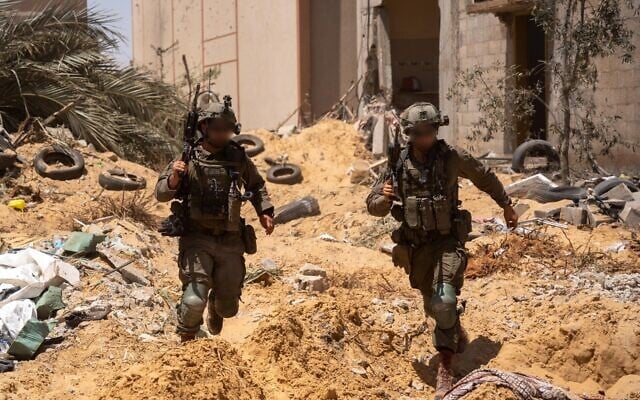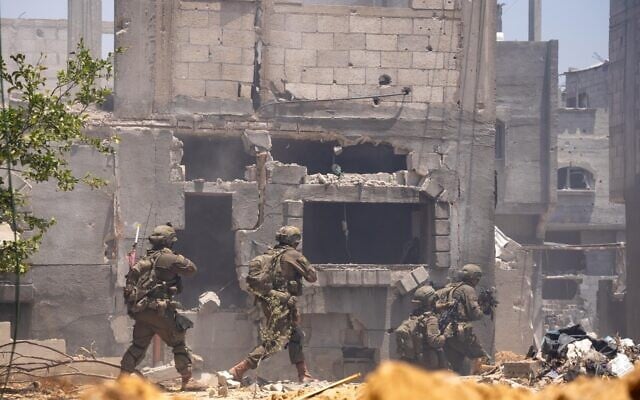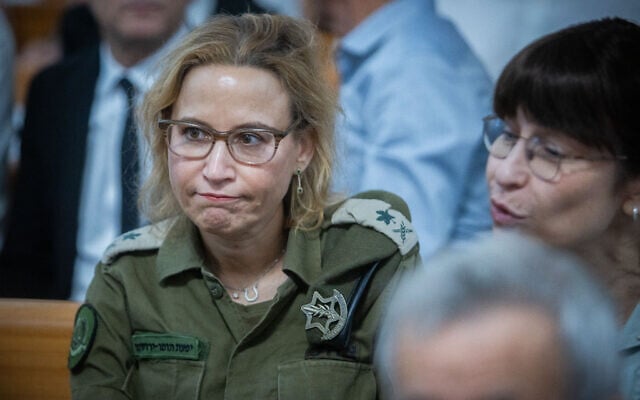



The Israel Defense Forces on Monday evening released the results of a preliminary investigation into the deaths of four troops in an explosion at a booby-trapped building in southern Gaza’s Khan Younis last week.
The explosion and subsequent building collapse on Friday morning killed Sgt. Maj. (res.) Chen Gross, Staff Sgt. Yoav Raver, Sgt. First Class Tom Rotstein and Staff Sgt. Uri Yhonatan Cohen, and wounded five other soldiers.
The probe found that the soldiers carried out numerous steps to rule out threats before entering the building, and upon noticing a suspicious finding, they alerted a bomb disposal squad.
According to the IDF’s investigation, several days before the incident, troops operating in the area in Khan Younis used “a variety of intelligence means to scan the buildings ahead of future activity.”
After the examination, the military suspected that several buildings were booby-trapped.
Still, IDF officials, during an assessment before the incident, decided that some of the buildings in the area would need to be used for the army’s planned activity. The IDF often uses buildings in Gaza as makeshift command centers during its operations against Hamas.
Two of the buildings were defined as likely booby-trapped, and their “benefit” for the activity was low, and the risk was unnecessary; therefore, they were bombed from the air and destroyed, the probe found.
Next to a third building, the IDF located what it suspected was an explosive device, but due to the “operational need and the building being essential” for operations in the area, it was decided to try and disarm the suspected bomb.
The IDF began a series of actions to rule out or neutralize the suspected explosive device before sending troops into the area. The actions involved sending a drone into the building and scanning for the suspected explosive.
The drone footage was reviewed by the commander of the force operating in the area, and the military came to the conclusion that it was not an explosive device, and there were no suspicious indications that the building was booby-trapped.
The troops also opened fire on the building’s two floors before approaching the area. Gunfire was also directed against the building a day prior by combat engineers.
Right before the troops entered the building, the soldiers hurled an explosive device into the first floor, in a last attempt to try and set off any possible booby traps.
The first floor of the two-story building was scanned by the forces and found to be clear of any possible explosives.
The troops then reached the second floor and spotted suspicious findings. The troops called for the bomb disposal squad, and the commander of the force made the rest of the troops step back, while staying with his signals soldier on the staircase.
Moments later, the explosive device was detonated against the forces, killing four and wounding five.
The IDF investigation has so far been unable to determine how the explosive was activated or what type of bomb was used.
The military said that the troops “acted professionally in a high-risk combat zone, and did the best they could to rule out all threats.”
The publication of the investigation came after the right-wing Channel 14 channel claimed that the building was not targeted in an airstrike because of an order given by the army’s top lawyer.
Channel 14 claimed that the IDF had sent troops into the building rather than targeting it in an airstrike because Military Advocate General Maj. Gen. Yifat Tomer-Yerushalmi had ostensibly changed army protocol to prohibit striking the structure as doing so would result in “high collateral damage.”
In an unusual move, IDF Chief of Staff Lt. Gen. Eyal Zamir issued a statement on Sunday night rejecting the “false, repeated, and baseless attacks regarding the conduct of the Military Advocate General.”
Israel launched its war in Gaza following the October 7, 2023, Hamas assault on southern Israel that killed some 1,200 people and saw another 251 taken hostage. Terror groups in Gaza continue to hold 55 hostages, including the bodies of at least 33 confirmed dead by the IDF, and 20 who are believed to be alive. There are grave concerns for the well-being of two others, Israeli officials have said.
Israel’s toll in the ground offensive against Hamas in Gaza and in military operations along the border with the Strip stands at 429. The toll includes two police officers and three Defense Ministry civilian contractors.



